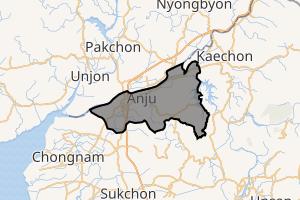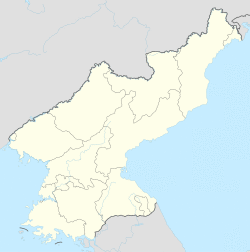Anju 안주시 | |
|---|---|
Municipal City | |
| Korean transcription(s) | |
| • Chosŏn'gŭl | 안주시 |
| • Hancha | 安州市 |
| • McCune-Reischauer | Anju-si |
| • Revised Romanization | Anju-si |
 View of Anju | |
 Map of South Pyongan showing the location of Anju | |
 | |
| Coordinates: 39°37′12″N 125°39′36″E / 39.62000°N 125.66000°E | |
| Country | North Korea |
| Province | South P'yongan |
| Administrative divisions | 20 tong, 22 ri |
| Population (2008[1]) | |
| • Total | 240,117 |
| • Dialect | P'yŏngan |
| Time zone | UTC+9 (Pyongyang Time) |
Anju-si (Korean pronunciation: [an.dzu]) is a city in the South P'yŏngan province of North Korea. Its population was 240,117 in 2008.[1] The Ch'ongch'on River passes through Anju.
Climate
| Climate data for Anju, South Pyongan (1981–2010) | |||||||||||||
|---|---|---|---|---|---|---|---|---|---|---|---|---|---|
| Month | Jan | Feb | Mar | Apr | May | Jun | Jul | Aug | Sep | Oct | Nov | Dec | Year |
| Average high °C (°F) | −1.7 (28.9) | 2.1 (35.8) | 8.2 (46.8) | 16.1 (61.0) | 21.8 (71.2) | 26.0 (78.8) | 27.8 (82.0) | 28.8 (83.8) | 25.0 (77.0) | 18.3 (64.9) | 8.4 (47.1) | 1.0 (33.8) | 15.2 (59.4) |
| Daily mean °C (°F) | −7.3 (18.9) | −3.5 (25.7) | 2.7 (36.9) | 10.0 (50.0) | 15.9 (60.6) | 20.8 (69.4) | 23.8 (74.8) | 24.2 (75.6) | 19.0 (66.2) | 11.7 (53.1) | 3.3 (37.9) | −3.8 (25.2) | 9.7 (49.5) |
| Average low °C (°F) | −12.7 (9.1) | −8.7 (16.3) | −2.3 (27.9) | 4.2 (39.6) | 10.4 (50.7) | 16.1 (61.0) | 20.3 (68.5) | 20.3 (68.5) | 14.0 (57.2) | 6.2 (43.2) | −1.3 (29.7) | −8.1 (17.4) | 4.9 (40.8) |
| Average precipitation mm (inches) | 10.0 (0.39) | 13.8 (0.54) | 28.7 (1.13) | 46.1 (1.81) | 72.8 (2.87) | 97.3 (3.83) | 285.2 (11.23) | 220.7 (8.69) | 96.8 (3.81) | 44.3 (1.74) | 33.1 (1.30) | 14.0 (0.55) | 962.8 (37.91) |
| Average precipitation days (≥ 0.1 mm) | 3.8 | 3.0 | 4.3 | 5.8 | 7.6 | 8.2 | 13.4 | 10.4 | 6.3 | 5.2 | 5.8 | 5.0 | 78.8 |
| Average snowy days | 4.1 | 3.1 | 2.4 | 0.2 | 0.0 | 0.0 | 0.0 | 0.0 | 0.0 | 0.0 | 1.8 | 4.9 | 16.5 |
| Average relative humidity (%) | 72.0 | 68.9 | 68.6 | 67.8 | 72.1 | 76.8 | 83.7 | 82.5 | 77.3 | 73.5 | 73.3 | 72.0 | 74.0 |
| Source: Korea Meteorological Administration[2] | |||||||||||||
Administrative divisions
Anju-si is divided into 20 tong (neighbourhoods) and 22 ri (villages):
|
|
Economy
Anju lies near large deposits of anthracite coal, and contains one of the largest coal production facilities in the country.[3] The deposits contain more than 130 million metric tons of coal.[4] Namhŭng-dong is the location of the Namhŭng Youth Chemical Complex, one of North Korea's most important chemical combines.[5] Anju also contains at least one hotel open for foreigners, used primarily to accommodate for more travelers during peak holiday times.[6]
Transportation
Anju-si is served by several stations on the P'yŏngŭi and Kaech'ŏn lines of the Korean State Railway.
Anju has a trolleybus system with one line. It formerly had another line to Namhung Youth Chemical Complex that closed in 2000.[7]
See also
- List of cities in North Korea
References
- ^ a b North Korean Central Statistic Bureau, 2008 Census.
- ^ "30 years report of Meteorological Observations in North Korea" (in Korean). Korea Meteorological Administration. pp. 232–281. Archived from the original on 21 December 2020. Retrieved 25 December 2020.
- ^ North Korea Handbook. M.E. Sharpe. 2003. ISBN 0765610043. Retrieved 2012-07-18.
- ^ Kuo, Chin S. (1994). "The mineral industry of North Korea" (PDF). Retrieved 2012-07-18.
- ^ Joseph S. Bermudez Jr. (10 April 2014). "North Korea's Namhung Youth Chemical Complex: Seven Years of Construction Pays Off". US-Korea Institute at SAIS.
- ^ Gareth Johnson (20 December 2019). "Anju County, North Korea". Young Pioneer Tours.
- ^ "Anju". transphoto.org. Retrieved 2021-01-02.
Further reading
- Dormels, Rainer. North Korea's Cities: Industrial facilities, internal structures and typification. Jimoondang, 2014. ISBN 978-89-6297-167-5
External links
| Rank | Name | Administrative division | Pop. | Rank | Name | Administrative division | Pop. | ||
|---|---|---|---|---|---|---|---|---|---|
 Pyongyang  Hamhung | 1 | Pyongyang | Pyongyang Capital City | 3,255,288 | 11 | Sunchon | South Pyongan | 297,317 |  Chongjin  Nampo |
| 2 | Hamhung | South Hamgyong | 768,551 | 12 | Pyongsong | South Pyongan | 284,386 | ||
| 3 | Chongjin | North Hamgyong | 667,929 | 13 | Haeju | South Hwanghae | 273,300 | ||
| 4 | Nampo | South Pyongan Province | 366,815 | 14 | Kanggye | Chagang | 251,971 | ||
| 5 | Wonsan | Kangwon | 363,127 | 15 | Anju | South Pyongan | 240,117 | ||
| 6 | Sinuiju | North Pyongan | 359,341 | 16 | Tokchon | South Pyongan | 237,133 | ||
| 7 | Tanchon | South Hamgyong | 345,875 | 17 | Kimchaek | North Hamgyong | 207,299 | ||
| 8 | Kaechon | South Pyongan | 319,554 | 18 | Rason | Rason Special Economic Zone | 196,954 | ||
| 9 | Kaesong | North Hwanghae | 308,440 | 19 | Kusong | North Pyongan | 196,515 | ||
| 10 | Sariwon | North Hwanghae | 307,764 | 20 | Hyesan | Ryanggang | 192,680 | ||

